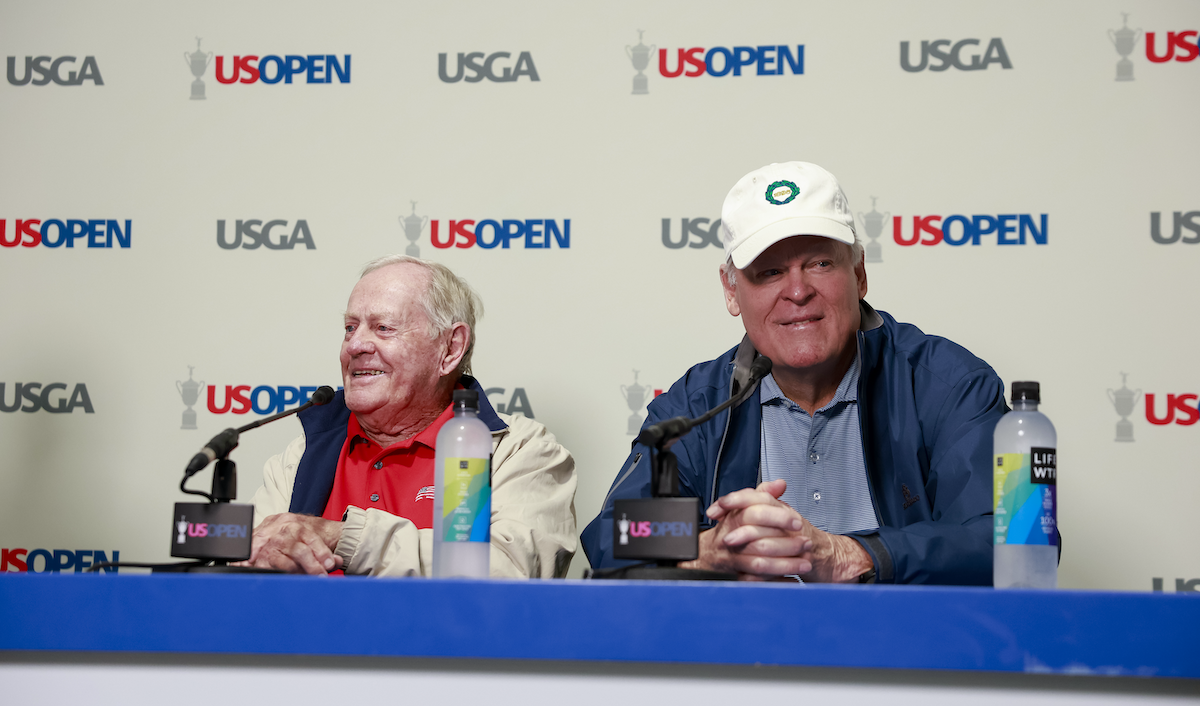Nicklaus, Miller reflect on iconic Oakmont wins, Palmer's legacy
By Josh Rowntree, Director of Communications • June 15, 2025
On Saturday at Oakmont Country Club, many of the game’s current greats battled the multitude of challenges presented by golf’s most difficult test at the U.S. Open.
In the media’s interview room, however, two of golf’s most prolific figures leisurely relived their iconic winning moments at Oakmont decades prior.
Jack Nicklaus and Johnny Miller, who each won their first major championship at Oakmont, shared memories of their memorable triumphs over the field and, perhaps more impressively, the course.
For Nicklaus, one of the game’s preeminent figures, a win at Oakmont in the 1962 U.S. Open meant more because of who he had to conquer along the way.
“The key was to beat Arnold Palmer,” Nicklaus said. “That was the key. I didn't know much about Oakmont. I didn't know anything about Oakmont. I came in ten days before the tournament and played a couple of times.
“I hadn't won. I finished second in '60 and fourth in '61 and I sort of felt like this was my Open. I didn't realize that — as a 22-year-old might not — that I was in Arnold Palmer's backyard.”
Indeed, he was. The locals rallied around Palmer that year, who was in search of his sixth championship and was far more of an established figure in the game that the upstart Nicklaus.
The two heavyweights grappled for four rounds, but finished their final round tied atop the leaderboard, setting up an 18-hole Sunday playoff.
Nicklaus surged under the pressure while dealing with the passion of about 10,000 of Palmer’s fans, known as ‘Arnie’s Army,’ trailing the group through the day.
He shot an even-par score of 71 in the playoff, topping Palmer by three strokes to win the tournament at 1-under.
“You had to figure these greens out and not let them get to you, and be patient,” said Nicklaus. “1-under par won the tournament. 1-under par doesn't win a lot of tournaments today, but it did then.”
Nicklaus and Palmer are forever connected, in large part, because of that U.S. Open, which is viewed now as somewhat of a passing of the torch from the game’s top figure to the next.
But Nicklaus is quick to recognize the impact of Arnold, and how it set the table for those after him.
“Arnold obviously had an enormous impact on the game,” Nicklaus said. “Arnold in many ways popularized the game of golf. He came along basically when television came along, and maybe television was great for Arnold, but Arnold was great for television and great for the game.
“He had a flair about him that nobody else had, and people loved him. And rightfully so. He earned what he got. He did a great job.”
Miller, now 78 years old, saw firsthand the importance that Palmer had on the game — and continues to have all these years later.
“Arnie had sort of like a Seve Ballesteros aura about him,” he said. “(There was) something about the way they walk and handled themselves. Arnie was a man's man, big-time man's man. He could have been with John Wayne as two leading guys in a movie.
“Yeah, it's nice to have a guy like that that can help push the game along, like Tiger Woods did.”
Miller’s final round in 1973 is considered by many to be the best in U.S. Open history. He carded a 63 on Sunday, rallying for outside of the top ten to win in dramatic fashion.
But that rally was set up by the power of Oakmont, which befuddled Miller in the three days leading up to his phenomenal finishing round.
“I was pretty upset about the 76 I shot the day before,” Miller said. “I was pretty down in the dumps after the 76. I thought, ‘well, that's the end of that.’ I had played well in the three U.S. Opens before. Top ten finishes. And after I birdied the first hole, that was a nice start.”
“I got a surge of adrenaline and started to be very tentative. My weakness in golf was my putting. I could putt good at times, but after the fourth hole, I thought, I've got a shot here if I can keep it up.”
Miller’s round of 63 in a U.S. Open has only been bettered twice since but still stands as the best 18-hole score at an Oakmont U.S. Open.
He claimed The Open Championship in 1976 and was runner-up in The Masters three times — with two coming after his Oakmont victory. He had a storied career in the television booth as well, becoming a polarizing figure on the entertainment side of the game.
Nicklaus went on to win 17 more major tournaments, leaving a legacy as the game’s greatest major championship competitor and has since become a revered course architect and business leader.
Both men have been well-decorated since their playing days as members of the World Golf Hall of Fame and each being recipients of the USGA’s top honor, the Bob Jones Award.
Those careers both involved numerous fantastic, historic moments. But the power of winning, especially at Oakmont, proved to be the starting points for their indelible legacies in the game.
For any media inquiries, please contact WPGA Director of Communications Josh Rowntree.
About the WPGA
Founded in 1899, the Western Pennsylvania Golf Association is the steward of amateur golf in the region. Started by five Member Clubs, the association now has nearly 200 Member Clubs and nearly 37,000 members. The WPGA conducts 14 individual competitions and 10 team events, and administers the WPGA Scholarship Fund and Western Pennsylvania Golf Hall of Fame.
